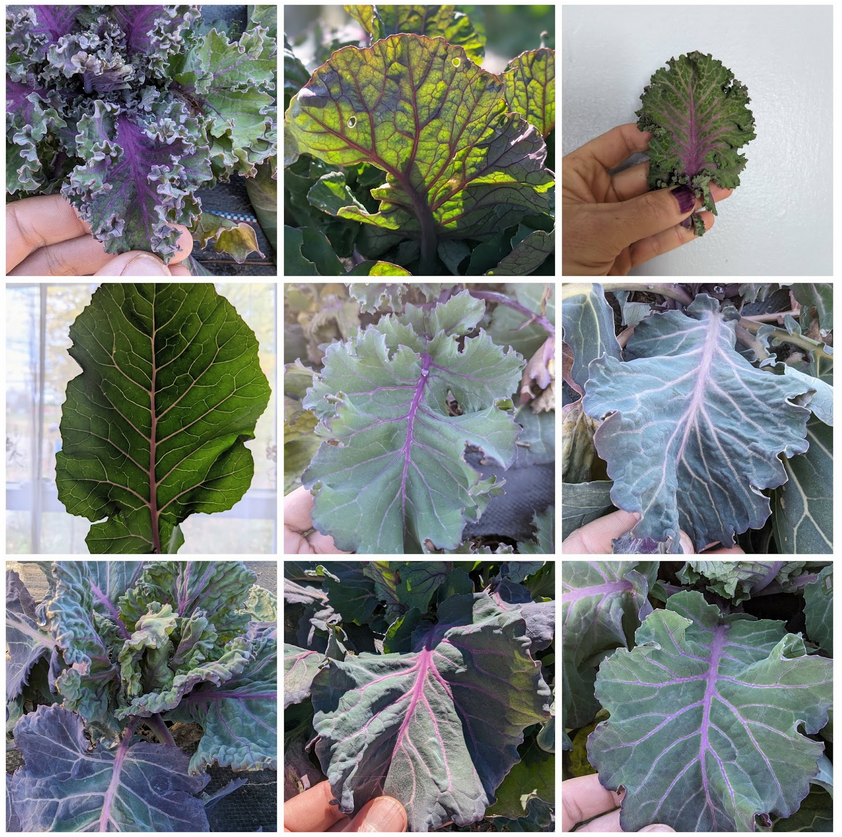The First Ultracross: Collards, a happy accident!
Since its inception, Utopian Seed Project has promoted increased levels of agrobiodiversity as a response to climate chaos. In the beginning we pursued varietal diversity (more varieties) and crop diversity (more crop species). In hindsight, it feels inevitable that we would end up working with highly diverse plant populations, but the first Ultracross was a happy accident.
In 2020, as a collaborator on the Heirloom Collard Project, we trialled 21 varieties to explore some of the diversity in the collection (Read the full story of collard diversity here: From Heirloom to Ultracross). We loved seeing all the phenotypes, and we worked with chefs to taste many tender and beautiful collards. One important observation is that these ‘heirloom’ varieties displayed high levels of intra-varietal diversity. The assumption we made was that the community seed keepers who had stewarded these seeds didn’t place a huge amount of value on hyper uniformity.
Potential genetics represented in the mix include:
William Moore; Fulton Stroud; Tabitha Dykes; Fuzzy’s Cabbage Collard; E.B. Paul; Jernigan Yellow Cabbage Collard; Yellow Cabbage Collard; Georgia; White Cabbage Collard; Willis Collard Greens; Ole Timey Blue; Georgia Blue Stem; North Carolina Yellow; Green Glaze, McCormack’s; White Mountain Cabbage Collard; Green Glaze; Miss Annie Pearl Counselman; Brickhouse Old Collard; Lottie Collard; Vates; Georgia Southern.
The plan never included seed saving because collards are obligate outcrossing and we had no way to isolate each variety. However, the part of the field the collards were occupying was not immediately needed, so we allowed the collards to continue growing after the trial data had been collected. The collards were unprotected and more or less ignored. That winter we experienced a sudden drop in temperature - a severe temperature swing from the high 70s down to a low around 8F. I expected to have lost all of the collards (8F uncovered is tough for collards at the best of times, let alone with the rapid swing). What we experienced in the field was about 40% plant loss, but at the same time, many of the survivors looked quite undeterred. An interesting observation was that the surviving plants were spread out across the 21 varieties. Looking at a healthy plant and a mushy plant next to each other made it extremely clear that some plants had a genetic advantage for surviving cold weather.
We decided that a super tough, yet deliciously tender, and beautifully diverse collard mix sounded like a worthwhile project. Our simple strategy was to allow any winter survivors to flower and set seed. The obligate outcrossing nature of collards (highly promiscuous) ensured that everything would be completely shaken up. As we started sharing online about our highly diverse collection of collard seeds, two close Heirloom Collard Project collaborators (Mel Edwards and Mel Desa) created the term ultracross. First as a description i.e. that’s an ultra cross. Second as a catchy hashtag. And from that point forward we have described this diverse mix as an ultracross.
Purple Ultracross Collard Selections
The Ultracross Collards have been well received and are now distributed by multiple seed companies and grown across the United States of America. Along the way, we have maintained a highly diverse population of environmentally selected collards in Western NC. They shift and change with the seasons and are regularly praised for their field hardiness and kitchen tenderness. We have also heard a lot of enthusiasm about purple phenotypes and have begun the work of selecting a Purple Ultracross Collard population. Each year, we cull the non-purple plants and allow the most purple to go to seed. This is an ongoing and exciting selection process!
The concept of diverse seed populations is not new, it is ancient. The newer model of hyper-uniform varieties, created in a centralized system, and sold through seed companies is the new concept. The Ultracross concept stands on the shoulders of traditional landrace culture and diverse seed populations that still exist today.


